On Friday 13 i spent an extra day in Huddersfield to attend the Biorama organized by Capsula and the Digital Research Unit. The objective was to illustrate new directions in art, science and technology by bringing together artists who explore notions of life, science and digital realities.
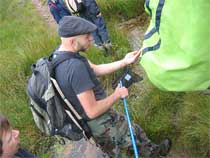
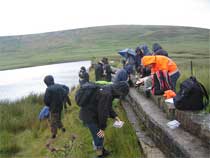
Biorama also puts the research carried out by Andy Gracie (whom i interviewed a while ago) during his 3-month residency at DRU into a broader context. His project weaves together the microbiology of the Pennines around Marsden Moor, traditional and digital networking systems, satellite communications, perceptions of landscape and the history and possible future of interstellar communication.
During the morning we went for a long but extremely fun hike under the rain. We followed Andy and Brandon Ballangee, looking for frogs, getting the lowdown on the nematodes, collecting samples, and watching organisms under the lens of our pocket microscopes. Searching for things we can’t see and that crawl under our feet and trying somehow to connect them with what we cannot see either because it is way too high above our head.
In the afternoon, we headed to the DRU and the artists’ talks kicked off with Andy’s presention of his work, this time it was dry, we sat on chairs and there were plenty of snacks on hand. Part of his research investigates communication with living forms we might yet not have encountered. Previous attempts to communicate with them include:
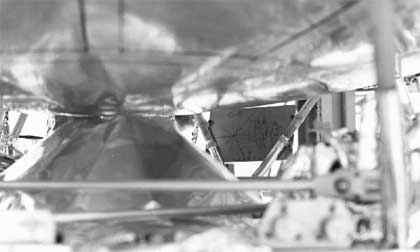 The Pioneer Plaque
The Pioneer Plaque
– the Pioneer Plaque, on board of the unmanned spacecraft Pioneer 10 and Pioneer 11, displays a pictorial message from mankind. The figures and symbols are designed to provide information about the origin of the spacecraft. It serves as a kind of interstellar “message in a bottle”.
– the Voyager Golden Record, included in the two Voyager spacecraft launched in 1977, it contains sounds and images that portray the diversity of life and culture on Earth. It is intended for any intelligent extraterrestrial life form, or far future humans, that may find it.
There is also the hypothesis to discover microbial life somewhere in our solar system and thus the desire to communicate with them. Some serious issues are at stake, such as nuclear waste dumps. How do you warn people not to dig it up for another 10,000 years? There is a high probability that our current form of civilization won’t be around in 12000AD so a simple ‘Danger, Keep Out!’ may not work. Think about Stonehenge, it is relatively not that far away back in time, yet we still haven’t got much clue on what the construction means.
The U.S. Department of Energy has been recently looking at this issue and wondering what to do about the warning markers at the Waste Isolation Pilot Plant (WIPP) at Yucca Mountain. Various plans have been proposed such as making it a big spikey forboding landscape.
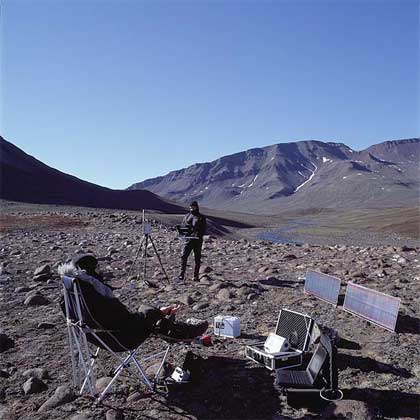 photo credit: Anthony Oliver
photo credit: Anthony Oliver
After Andy, artists were invited to take the floor. Starting with London Fieldworks. Bruce Gilchrist & Jo Joelson are interested in human relationship with the natural environment, their work tends to bring elements of the landscape (mostly from rather extreme environments) into an urban context.
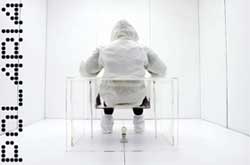
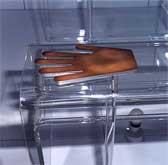
For Polaria they collected data about light and physiology during the transition from 24 hour daylight to the twilight onset of winter in North East Greenland and brought the data back into a studio and translated it into a virtual daylight installation. They left the data open for the public to interpret it.
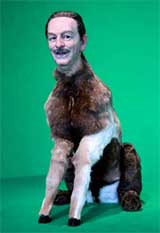 The Little Earth installation consisted of synchronised video shot on Haldde Mountain in the Norwegian Arctic, Ben Nevis in Scotland, and on the island of Svalbard, with computer animations of the Earth’s magnetosphere modeled by the Leicester Radio & Space Plasma Physics Group, the science partner in this arts/science collaboration. The video, shot from 4 perspectives is projected onto a suspended cube-like structure, with a surround sound score and narration.
The Little Earth installation consisted of synchronised video shot on Haldde Mountain in the Norwegian Arctic, Ben Nevis in Scotland, and on the island of Svalbard, with computer animations of the Earth’s magnetosphere modeled by the Leicester Radio & Space Plasma Physics Group, the science partner in this arts/science collaboration. The video, shot from 4 perspectives is projected onto a suspended cube-like structure, with a surround sound score and narration.
London Fieldworks is currently working on Prince of the Petrified Forest. Working with the personal myth of Walt Disney, cryogenically frozen at the point of death, the artists proposed to reincarnate him into an animatronic Hexer alter-ego (image) which would star in their film Prince Of The Petrified Forest – part inspired by the seminal eco novel, Bambi by Felix Salten and Prospect of Immortality by Robert Ettinger, “the father of cryonics” but also by stories read in the press such as the one of the mouse put in ‘suspended animation’. The themes of the movie are hibernation and suspension.
The animatronic is a monstrous hybrid of Disney and his iconic characters, Bambi and Thumper.
SpaceBaby, supported by art science agency The Arts Catalyst, explored inverted sleep pattern and its possible effect on human genes, referencing research interest of space agencies into human hibernation. The artists slept through the day in specially constructed “hibernaculum” and scientists from the University of Leicester Dept. of Genetics were taking blood samples to monitor the effect the reverse sleep pattern had on their genes. The project will be turned into a film.


 SpaceBaby, just like the Disney chimera project, made reference to recent scientific experiment into the induction of suspended states of animation in non-hibernatory animals. The project imagines space agencies transferring these applications to humans to facilitate long distance space flight. C-lab has some more images of the installation.
SpaceBaby, just like the Disney chimera project, made reference to recent scientific experiment into the induction of suspended states of animation in non-hibernatory animals. The project imagines space agencies transferring these applications to humans to facilitate long distance space flight. C-lab has some more images of the installation.
